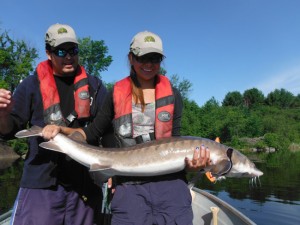Spawning assessment complete

By Maureen Peltier
GARDEN RIVER FN – As one of 62 organizations across Ontario to successfully garner Species at Risk Stewardship Funding, the Anishinabek/Ontario Fisheries Resource Centre effectively completed the first of a three-year Lake Sturgeon spawning assessment in the Garden River from May 27 to July 19, 2013. The objective of this study was to evaluate Lake Sturgeon spawning efforts and habitat in the Garden River, since very little information is known about this population.
In partnership with Garden River First Nation, Fisheries and Oceans Canada, Ontario Ministry of Natural Resources, and Lake Superior State University, a total of 109 Lake Sturgeon were captured during this study.
Water temperatures during this time ranged from 11°C to 21°C and a combination of gill nets, larval drift nets, and egg mats were deployed to monitor Lake Sturgeon spawning efforts. With the use of gill nets, a total of 12 adult Lake Sturgeon were captured, with the first being caught on May 29. A total of 97 larval Lake Sturgeon were captured below the Highway 17B bridge, with the first capture occurring on June 8.
It was estimated that the larval Lake Sturgeon were approximately three weeks old upon capture, which suggests that spawning occurred in mid-May. Larval Lake Sturgeon were retained and will be genotyped by Lake Superior State University to estimate the total number of spawning individuals within the Garden River.
As with all of the A/OFRC’s field projects, Traditional Ecological Knowledge was also gathered to obtain a more accurate portrait of the Garden River Lake Sturgeon population. Surveys were conducted with Garden River First Nation community members to identify and document traditional knowledge relating to Lake Sturgeon and its use of the Garden River.
Surveys were conducted by Troy Pine and Jayce Chiblow, both of whom are Garden River First Nation community members. More than 20 surveys were conducted with community members and the information gathered will be incorporated into the study design for future sampling.


